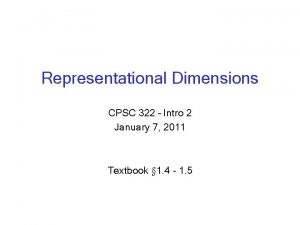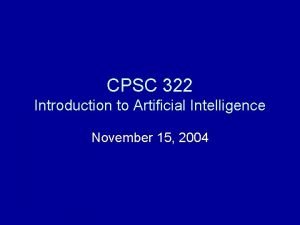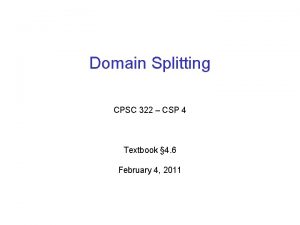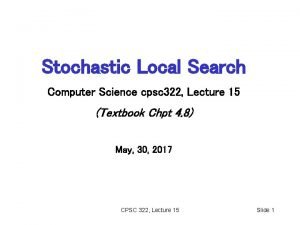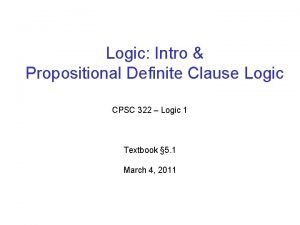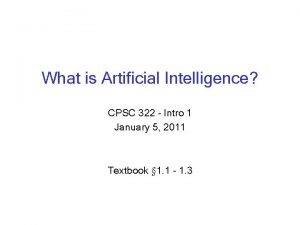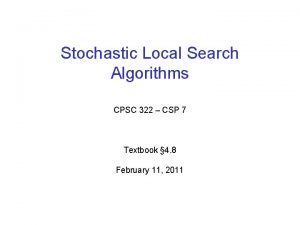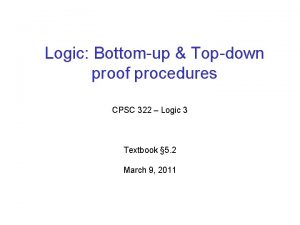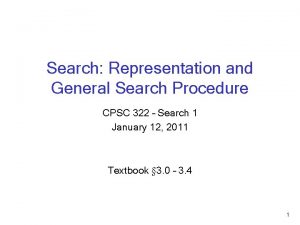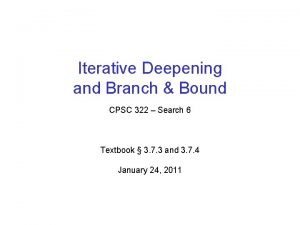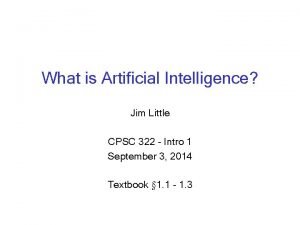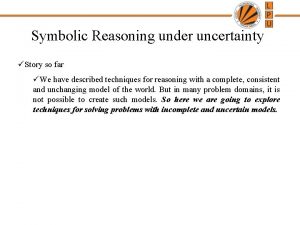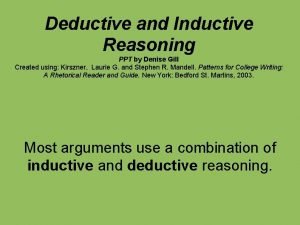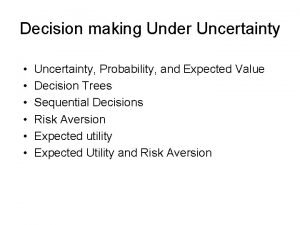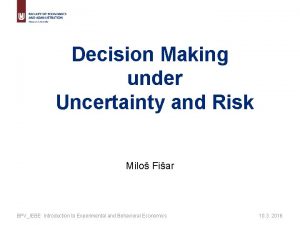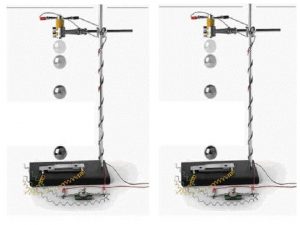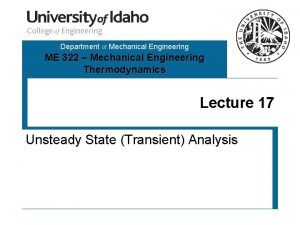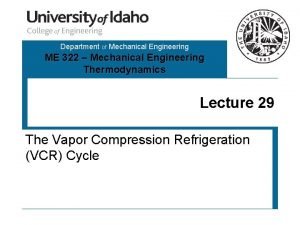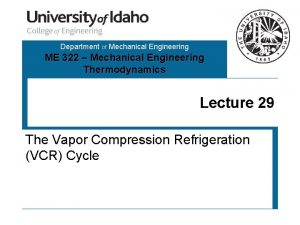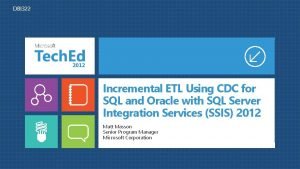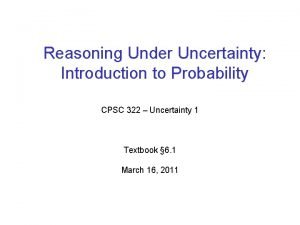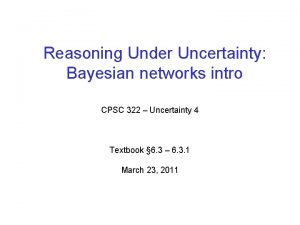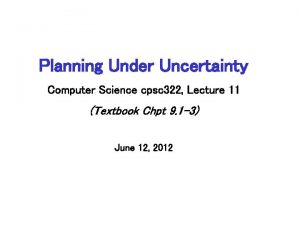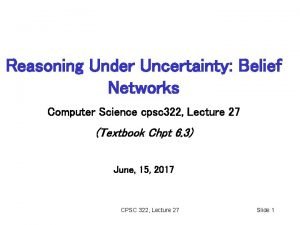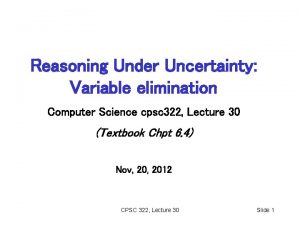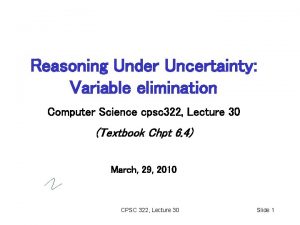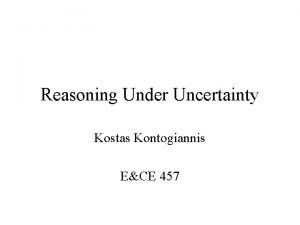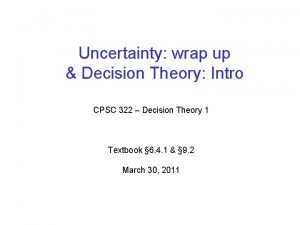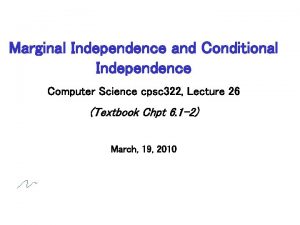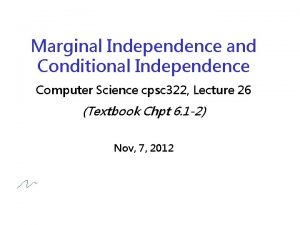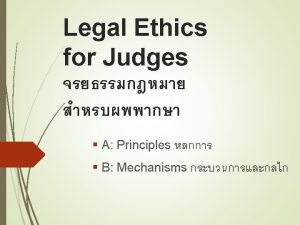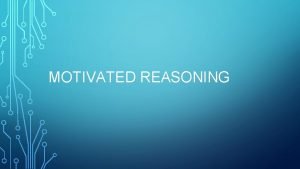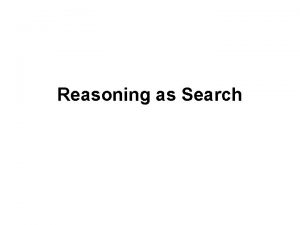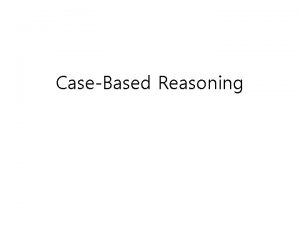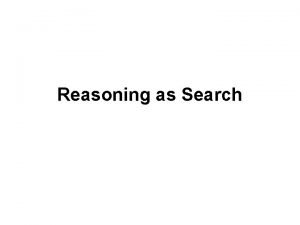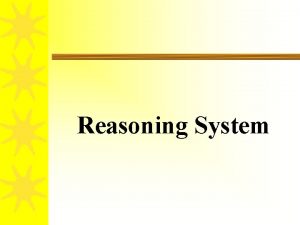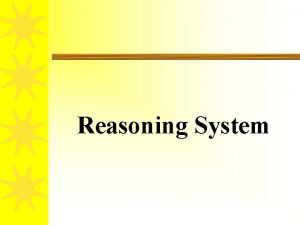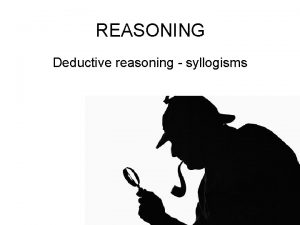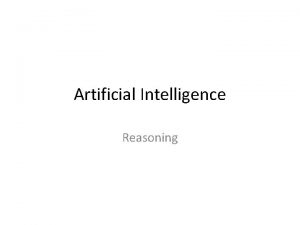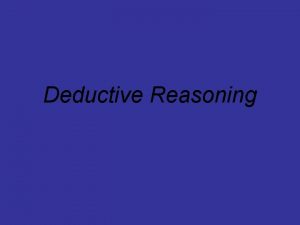Reasoning Under Uncertainty Independence CPSC 322 Uncertainty 3









































- Slides: 41

Reasoning Under Uncertainty: Independence CPSC 322 – Uncertainty 3 Textbook § 6. 2 March 21, 2011

Lecture Overview • Recap – Conditioning & Inference by Enumeration – Bayes Rule & Chain Rule • Independence – Marginal Independence – Conditional Independence – Time-permitting: Rainbow Robot example 2

Recap: Conditioning • Conditioning: revise beliefs based on new observations • We need to integrate two sources of knowledge – Prior probability distribution P(X): all background knowledge – New evidence e • Combine the two to form a posterior probability distribution – The conditional probability P(h|e) 3

Recap: Example for conditioning • You have a prior for the joint distribution of weather and temperature, and the marginal distribution of temperature Possible world Weather Temperature µ(w) w 1 sunny hot 0. 10 hot ? w 2 sunny mild 0. 20 mild ? w 3 sunny cold 0. 10 cold ? w 4 cloudy hot 0. 05 w 5 cloudy mild 0. 35 w 6 cloudy cold 0. 20 T P(T|W=sunny) • Now, you look outside and see that it’s sunny – You are certain that you’re in world w 1, w 2, or w 3 4

Recap: Example for conditioning • You have a prior for the joint distribution of weather and temperature, and the marginal distribution of temperature Possible world Weather Temperature w 1 sunny hot w 2 sunny w 3 µ(w) T P(T|W=sunny) 0. 10 hot 0. 10/0. 40=0. 25 mild 0. 20/0. 40=0. 50 sunny cold 0. 10/0. 40=0. 25 w 4 cloudy hot 0. 05 w 5 cloudy mild 0. 35 w 6 cloudy cold 0. 20 • Now, you look outside and see that it’s sunny – You are certain that you’re in world w 1, w 2, or w 3 – To get the conditional probability, you simply renormalize to sum to 1 – 0. 10+0. 20+0. 10=0. 40 5

Recap: Conditional probability • Possible world Weather Temperature w 1 sunny hot w 2 sunny w 3 µ(w) T P(T|W=sunny) 0. 10 hot 0. 10/0. 40=0. 25 mild 0. 20/0. 40=0. 50 sunny cold 0. 10/0. 40=0. 25 w 4 cloudy hot 0. 05 w 5 cloudy mild 0. 35 w 6 cloudy cold 0. 20 6

Recap: Inference by Enumeration • Great, we can compute arbitrary probabilities now! • Given – Prior joint probability distribution (JPD) on set of variables X – specific values e for the evidence variables E (subset of X) • We want to compute – posterior joint distribution of query variables Y (a subset of X) given evidence e • Step 1: Condition to get distribution P(X|e) • Step 2: Marginalize to get distribution P(Y|e) • Generally applicable, but memory-heavy and slow 7

Recap: Bayes rule and Chain Rule • 8

Lecture Overview • Recap – Conditioning & Inference by Enumeration – Bayes Rule & Chain Rule • Independence – Marginal Independence – Conditional Independence – Time-permitting: Rainbow Robot example 9

Marginal Independence: example • Some variables are independent: – Knowing the value of one does not tell you anything about the other – Example: variables W (weather) and R (result of a die throw) • Let’s compare P(W) vs. P(W | R = 6 ) • What is P(W=cloudy) ? 0. 066 0. 1 0. 4 0. 6 Weather W Result R P(W, R) sunny 1 0. 066 sunny 2 0. 066 sunny 3 0. 066 sunny 4 0. 066 sunny 5 0. 066 sunny 6 0. 066 cloudy 1 0. 1 cloudy 2 0. 1 cloudy 3 0. 1 cloudy 4 0. 1 cloudy 5 0. 1 cloudy 6 0. 1 10

Marginal Independence: example • Some variables are independent: – Knowing the value of one does not tell you anything about the other – Example: variables W (weather) and R (result of a die throw) • Let’s compare P(W) vs. P(W | R = 6 ) • What is P(W=cloudy) ? – P(W=cloudy) = r dom(R) P(W=cloudy, R = r) = 0. 1+0. 1 = 0. 6 • What is P(W=cloudy|R=6) ? 0. 066/0. 166 0. 1/0. 166 0. 066+0. 1/0. 6 Weather W Result R P(W, R) sunny 1 0. 066 sunny 2 0. 066 sunny 3 0. 066 sunny 4 0. 066 sunny 5 0. 066 sunny 6 0. 066 cloudy 1 0. 1 cloudy 2 0. 1 cloudy 3 0. 1 cloudy 4 0. 1 cloudy 5 0. 1 cloudy 6 0. 1 11

Marginal Independence: example • Weather W Result R P(W, R) sunny 1 0. 066 sunny 2 0. 066 sunny 3 0. 066 sunny 4 0. 066 sunny 5 0. 066 sunny 6 0. 066 cloudy 1 0. 1 cloudy 2 0. 1 cloudy 3 0. 1 cloudy 4 0. 1 cloudy 5 0. 1 cloudy 6 0. 1 12

Marginal Independence: example • Weather W Result R P(W, R) sunny 1 0. 066 sunny 2 0. 066 sunny 3 0. 066 sunny 4 0. 066 sunny 5 0. 066 sunny 6 0. 066 cloudy 1 0. 1 cloudy 2 0. 1 cloudy 3 0. 1 cloudy 4 0. 1 cloudy 5 0. 1 cloudy 6 0. 1 13

Marginal Independence: example • Some variables are independent: – Knowing the value of one does not tell you anything about the other – Example: variables W (weather) and R (result of a die throw) • Let’s compare P(W) vs. P(W | R = 6 ) • The two distributions are identical • Knowing the result of the die does not change our belief in the weather W P(W) sunny 0. 4 cloudy 0. 6 Weather W Result R P(W, R) sunny 1 0. 066 sunny 2 0. 066 sunny 3 0. 066 sunny 4 0. 066 sunny 5 0. 066 sunny 6 0. 066 cloudy 1 0. 1 cloudy 2 0. 1 cloudy 3 0. 1 cloudy 4 0. 1 Weather W P(W|R=6) cloudy 5 0. 1 sunny 0. 066/0. 166=0. 4 cloudy 6 0. 1 cloudy 0. 1/0. 166=0. 6 14

Marginal Independence • Intuitively: if X and Y are marginally independent, then – learning that Y=y does not change your belief in X – and this is true for all values y that Y could take • For example, weather is marginally independent from the result of a die throw 15

Examples for marginal independence • Results C 1 and C 2 of two tosses of a fair coin • Are C 1 and C 2 marginally independent? yes no C 1 C 2 P(C 1 , C 2) heads 0. 25 heads tails 0. 25 tails heads 0. 25 tails 0. 25 16

Examples for marginal independence • Results C 1 and C 2 of two tosses of a fair coin • Are C 1 and C 2 marginally independent? – Yes. All probabilities in the definition above are 0. 5. C 1 C 2 P(C 1 , C 2) heads 0. 25 heads tails 0. 25 tails heads 0. 25 tails 0. 25 17

Examples for marginal independence Weather W • Are Weather and Temperature marginally independent? yes no Temperature T P(W, T) sunny hot 0. 10 sunny mild 0. 20 sunny cold 0. 10 cloudy hot 0. 05 cloudy mild 0. 35 cloudy cold 0. 20

Examples for marginal independence Weather W • Are Weather and Temperature marginally independent? – No. We saw before that knowing the Temperature changes our belief on the weather – E. g. P(hot) = 0. 10+0. 05=0. 15 P(hot|cloudy) = 0. 05/0. 6 0. 083 Temperature T P(W, T) sunny hot 0. 10 sunny mild 0. 20 sunny cold 0. 10 cloudy hot 0. 05 cloudy mild 0. 35 cloudy cold 0. 20

Examples for marginal independence • Intuitively (without numbers): – Boolean random variable “Canucks win the Stanley Cup this season” – Numerical random variable “Canucks’ revenue last season” ? – Are the two marginally independent? yes no 20

Examples for marginal independence • Intuitively (without numbers): – Boolean random variable “Canucks win the Stanley Cup this season” – Numerical random variable “Canucks’ revenue last season” ? – Are the two marginally independent? • No! Without revenue they cannot afford to keep their best players 21

Exploiting marginal independence • 22

Exploiting marginal independence • 2 n 2 n 2+n n 2 23

Exploiting marginal independence • 2 n 2 n 2+n n 2 24

Exploiting marginal independence • 25

Lecture Overview • Recap – Conditioning & Inference by Enumeration – Bayes Rule & Chain Rule • Independence – Marginal Independence – Conditional Independence – Time-permitting: Rainbow Robot example 26

Follow-up Example • Intuitively (without numbers): – Boolean random variable “Canucks win the Stanley Cup this season” – Numerical random variable “Canucks’ revenue last season” ? – Are the two marginally independent? • No! Without revenue they cannot afford to keep their best players – But they are conditionally independent given the Canucks line-up • Once we know who is playing then learning their revenue last year won’t change our belief in their chances 27

Conditional Independence • Intuitively: if X and Y are conditionally independent given Z, then – learning that Y=y does not change your belief in X when we already know Z=z – and this is true for all values y that Y could take and all values z that Z could take 28

Example for Conditional Independence • Whether light l 1 is lit is conditionally independent from the position of switch s 2 given whethere is power in wire w 0 • Once we know Power(w 0) learning values for any other variable will not change our beliefs about Lit(l 1) – I. e. , Lit(l 1) is independent of any other variable given Power(w 0) 29

Example: conditionally but not marginally independent • Exam. Grade and Assignment. Grade are not marginally independent – Students who do well on one typically do well on the other • But conditional on Understood. Material, they are independent – Variable Understood. Material is a common cause of variables Exam. Grade and Assignment. Grade – Understood. Material shields any information we could get from Assignment. Grade Understood Material Assignment Grade Exam Grade 30

Example: marginally but not conditionally independent • Two variables can be marginally but not conditionally independent – – “Smoking At Sensor” S: resident smokes cigarette next to fire sensor “Fire” F: there is a fire somewhere in the building “Alarm” A: the fire alarm rings S and F are marginally independent • Learning S=true or S=false does not change your belief in F – But they are not conditionally independent given alarm • If the alarm rings and you learn S=true your belief in F decreases Smoking At Sensor Fire Alarm 31

Conditional vs. Marginal Independence • Two variables can be – Both marginally nor conditionally independent • Canucks. Win. Stanley. Cup and Lit(l 1) given Power(w 0) – Neither marginally nor conditionally independent • Temperature and Cloudiness given Wind – Conditionally but not marginally independent • Exam. Grade and Assignment. Grade given Understood. Material – Marginally but not conditionally independent • Smoking. At. Sensor and Fire given Alarm 32

Exploiting Conditional Independence • Example 1: Boolean variables A, B, C – C is conditionally independent of A given B – We can then rewrite P(C | A, B) as P(C|B)

Exploiting Conditional Independence • Example 2: Boolean variables A, B, C, D – – D is conditionally independent of A given C D is conditionally independent of B given C We can then rewrite P(D | A, B, C) as P(D|B, C) And can further rewrite P(D|B, C) as P(D|C)

Exploiting Conditional Independence • Recall the chain rule 35

Lecture Overview • Recap – Conditioning & Inference by Enumeration – Bayes Rule & Chain Rule • Independence – Marginal Independence – Conditional Independence – Time-permitting: Rainbow Robot example 36

Rainbow Robot Example • P(Position 2 | Position 0, Position 1, Sensors 2) – What variables is Position 2 cond. independent of given Position 1 ? Pos 0 Pos 1 Pos 2 Sens 1 Sens 2 37

Rainbow Robot Example • P(Pos 2 | Pos 0, Pos 1, Sens 2) – What variables is Pos 2 conditionally independent of given Pos 1 ? • Pos 2 is conditionally independent of Pos 0 given Pos 1 • Pos 2 is conditionally independent of Sens 1 given Pos 1 Pos 0 Pos 1 Pos 2 Sens 1 Sens 2 38

Rainbow Robot Example (cont’d) • Pos 2 is conditionally independent of Pos 0 and Sens 1 given Pos 1 Bayes rule Sens 2 is conditionally independent of Pos 1 given Pos 2 The denominator is a constant (does not depend on Pos 2). The probability just has to sum to 1. Pos 0 Pos 1 Pos 2 Sens 1 Sens 2 39

Rainbow Robot Example (cont’d) • Pos 0 Pos 1 Pos 2 Sens 1 Sens 2 40

Learning Goals For Today’s Class • Define and use marginal independence • Define and use conditional independence • Assignment 4 available on Web. CT – Due in 2 weeks – Do the questions early • Right after the material for the question has been covered in class • This will help you stay on track 41
 Cpsc 322
Cpsc 322 Mycin
Mycin Cpsc 322
Cpsc 322 Cpsc 322
Cpsc 322 Definite clause in ai
Definite clause in ai Cpsc 322: introduction to artificial intelligence
Cpsc 322: introduction to artificial intelligence Cpsc 322
Cpsc 322 Cpsc 322
Cpsc 322 Cpsc 322 ubc
Cpsc 322 ubc Cpsc 322
Cpsc 322 Iterative deepening search example
Iterative deepening search example Cpsc 322 ubc
Cpsc 322 ubc Reiters
Reiters Deductive and inductive reasoning ppt
Deductive and inductive reasoning ppt Expected profit under uncertainty
Expected profit under uncertainty Uncertainity in decision making
Uncertainity in decision making Decision-making under uncertainty
Decision-making under uncertainty Capital budgeting under risk and uncertainty
Capital budgeting under risk and uncertainty Inductive vs deductive geometry
Inductive vs deductive geometry Deductive vs inductive reasoning
Deductive vs inductive reasoning Inductive vs deductive reasoning
Inductive vs deductive reasoning Inductive vs deductive
Inductive vs deductive Inductive reasoning is reasoning based on patterns
Inductive reasoning is reasoning based on patterns Deductive reasoning vs inductive reasoning
Deductive reasoning vs inductive reasoning Deductive approach
Deductive approach How long ago was 322 bc
How long ago was 322 bc Aristote 384-322
Aristote 384-322 Nació en macedonia en el 384 a. c.
Nació en macedonia en el 384 a. c. Google soa
Google soa Me 322
Me 322 Eee 322
Eee 322 Me 322
Me 322 Br 322
Br 322 Cuál es el decreto de la red de apoyo
Cuál es el decreto de la red de apoyo Combustion products
Combustion products Me 322
Me 322 384-322
384-322 Octahedral stress theory
Octahedral stress theory Allopurinol gador 300 mg
Allopurinol gador 300 mg Sp_replincrementlsn
Sp_replincrementlsn Fe 322
Fe 322 322-185
322-185
